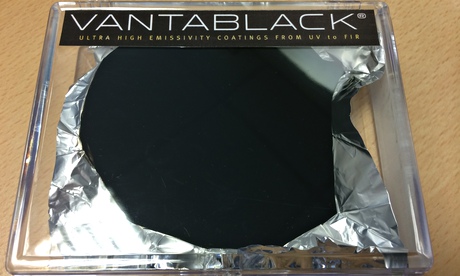
Vantablack is the new black. You haven't heard of it? It really is the new black, blacker than all previous blacks known to man, and the Guinness Book of Records. When you look at this new black, you see only a hole. If you were to wear a Little Vantablack Dress, people would see your hands poking out the ends of the sleeves, your legs below the hem, your neck and head – and the rest of you would appear two-dimensional. Total flatness is not the usual ambition of little black dresses, but this new material, which has been developed by British company Surrey NanoSystems, is intended for military and astronautical purposes, not sartorial ones.
The material is made of carbon nanotubes. "It grows very quickly," says Ben Jensen, the company's chief technical officer. "Take one of the hairs on your head. Split that hair 10,000 times and one of the strands that you take away is the size of the tubes that we grow." What does the material look like when it's growing? "We grow the tubes like a field of carbon grass. The tubes are spaced apart. When a light particle hits the material, it gets between the tubes and bounces around, is absorbed and converted to heat. Light goes in, but it can't get back out."
Very little gets out, at any rate. Carbon nanotubing was discovered as a material in the 1990s. Since then there has been a race towards the blackest black. Every few years, a deeper black is invented. This new black absorbs all but 0.035% of light (in technical terms, it has a Total Hemispherical Reflectance or THR of 0.035%). The previous world record for black was 0.04%. What makes the latest black particularly exciting is the fact that it can grow at lower temperatures – 400C, compared with the 750C at which Nasa has grown deep blacks. This means it can be grown on lighter materials, such as aluminium, increasing its practical applications.
Has Vantablack changed the way Jensen sees ordinary black? "We call this material super black," he says. Touch it and it feels like the metal it's grown upon.
How did they make their discovery? "We were in the research lab getting very frustrated. We raced down to the pub and had a lightbulb moment." It is interesting that even scientists searching for the deepest darkness possible think of their breakthrough as enlightenment. Presumably you need that if you are staring at the abyss every day.
Popular culture likes a new black. The phrase is an example of a "snowclone" and was alleged to have been invented by the US fashion editor Diana Vreeland, who was said to have described pink as "the new black". This is inaccurate, however, as Vreeland in fact described pink as "the navy blue of India", which is a different snowclone altogether. The Oxford English Dictionary has no record for "the new black", although the phrase was used in the Observer in December 1993 to describe the popularity of the colour white. Over the years there have been many new blacks. Chocolate brown was the new black in 1996. Grey has been the new black for the past decade. You do not need to be a colour to be the new black: anything popular will do. The TV show Orange Is the New Black is also the new black.
But for now, at least, Vantablack is the new black. It is not quite as catchy as Yves Klein Blue, mind. "No," says Jensen. "But this is a commercial material." Is he sick of hearing the phrase "the new black"? "I have heard that term a lot," he says. "But not yet."
"This is not a groundbreaking thing," says professor George Stylios at the school of textiles and design at Heriot-Watt university. "It's a progression of a group of scientists, of companies that try to manipulate materials to push the boundaries." He says they could also make a redder red and a bluer blue.
Jensen, incidentally, is already working on a blacker version of Vantablack. Another new black? It's only a matter of time.

